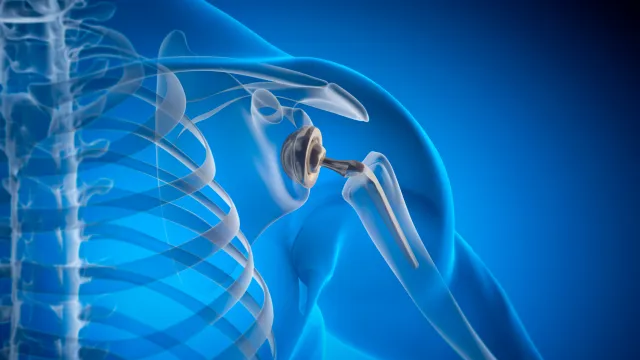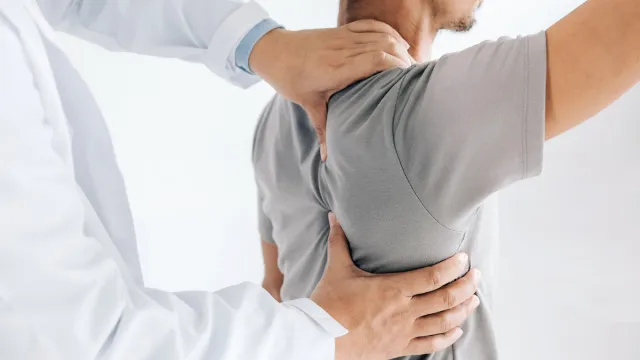
Shoulder Pain

Shoulder Pain
One of the most frequent concerns we see at South Shore Orthopedics is shoulder pain. Shoulder discomfort can originate from the neck, the shoulder joint itself, or the surrounding ligaments and tendons. When the pain comes from the joint, it often worsens with movement, making everyday activities like lifting, reaching, or carrying objects uncomfortable.

Common Causes of Shoulder Pain
Shoulder pain can be the result of a variety of conditions. If you have shoulder pain, you may be experiencing one of the following:
- Bursitis: Bursitis arises when there is irritation or inflammation of the bursa, which is a small sac filled with fluid that acts as a cushion between the rotator cuff tendons and shoulder blade.
- Frozen Shoulder: A condition where the shoulder becomes stiff and painful is referred to as adhesive capsulitis (or frozen shoulder).
- Rotator Cuff Tear: A rotator cuff tear is a tear in the tissues that connect the muscle to the bones around the shoulder joint.
- Shoulder Instability: When the shoulder partially dislocates, shoulder instability is often the result. It occurs when the shoulder joint is too loose and is capable of sliding around in the socket. Most causes of shoulder instability have an associated labral tear.
- Shoulder Dislocation: An injury in which the ball of the humerus moves out of the shoulder socket is characterized as a shoulder dislocation.
- Shoulder Arthritis: Shoulder arthritis leads to uncomfortable symptoms such as a limited range of motion and joint pain.
- SLAP Tear: An injury to the ring of fibrocartilage at the top of the socket of the shoulder joint or labrum is known as a SLAP tear.
- Labral Tear: An injury to the labrum in the shoulder can trigger a catching sensation and pain is a labral tear. Labral tears are often associated with instability systems.

When to See a Doctor
If you are coping with shoulder pain, you may be wondering whether you should visit a doctor. Shoulder pain that persists beyond several days, makes it impossible to use your arm or carry objects, was caused by an injury, arises at night, shows signs of infection such as a fever, or any other atypical symptoms warrants medical attention.
Shoulder Pain Treatment
At South Shore Orthopedics, we treat most shoulder pain with conservative measures such as rest, anti-inflammatory medications that can help ease pain and inflammation, ice and heat application, stretching, cortisone injections, and physical therapy. If your daily activities are limited because of shoulder pain, and don't improve with appropriate conservation treatment, surgery may be a viable option.
Commonly Performed Shoulder Surgeries:

Shoulder Arthroscopy
During a shoulder arthroscopy, a surgeon will insert a small camera into your shoulder joint. Most shoulders can be treated by this minimally invasive approach.

Shoulder Replacement
Shoulder replacement is reserved for instances where a patient has severe shoulder pain related to arthritis which limits his or her ability to move the arm.

Reverse Shoulder Replacement
A reverse shoulder replacement is a type of shoulder surgery designed for patients with severe rotator cuff damage or complex shoulder arthritis. Unlike a standard shoulder replacement, the "ball" and "socket" of the shoulder joint are reversed: the ball is attached to the shoulder blade (socket side), and the socket is placed on the arm bone (humerus). This design allows other muscles, like the deltoid, to compensate for a damaged rotator cuff, helping restore strength and movement in the shoulder. Reverse shoulder replacement can improve function, reduce pain, and is particularly helpful when a traditional shoulder replacement would not be effective.